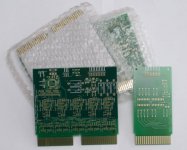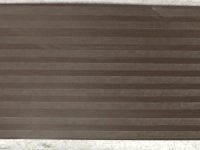m_thompson
Veteran Member
We are back to working on the LINCtapes in the PDP-12. They sometimes work OK, but most often don't. Sometimes we can mark a tape, but usually can't. One issue is glitches on a data track that we have not been able to trace or fix. We have swapped the TU56 for a TU55, including the data cable, but there was no change. We swapped all of the boards in the read section of the TC12 tape controller and saw no improvement.
Another issue is skew on the tape head that we replaced. On Saturday we measured about 5uS of skew using quite a few tapes that were were written by DEC. The head signal is about 5mV, so it is at the limits of my 'scope. There is also a large amount of 25mV RF noise mixed with the head signal that makes it difficult for the 'scope to sync on the head signal. We haven't been able to reduce or find the source of the RF noise.
The DEC head skew correction procedure calls for turning the tape over so it is oxide side up. This will reduce the head signal to about 1mV, so I don't think that my 'scope will be able to see it. The DEC skew procedure describes an amplifier for the head signals. I think that we will need to make one so my 'scope can see the 1mV signal. We will probably add a low-pass filter to the amplifier to eliminate the RF noise that we see.
We will use the old TU56 head with the open MARK coils to hunt for the RF noise today. That may be an impossible task, but it is worth a try.
Another issue is skew on the tape head that we replaced. On Saturday we measured about 5uS of skew using quite a few tapes that were were written by DEC. The head signal is about 5mV, so it is at the limits of my 'scope. There is also a large amount of 25mV RF noise mixed with the head signal that makes it difficult for the 'scope to sync on the head signal. We haven't been able to reduce or find the source of the RF noise.
The DEC head skew correction procedure calls for turning the tape over so it is oxide side up. This will reduce the head signal to about 1mV, so I don't think that my 'scope will be able to see it. The DEC skew procedure describes an amplifier for the head signals. I think that we will need to make one so my 'scope can see the 1mV signal. We will probably add a low-pass filter to the amplifier to eliminate the RF noise that we see.
We will use the old TU56 head with the open MARK coils to hunt for the RF noise today. That may be an impossible task, but it is worth a try.


